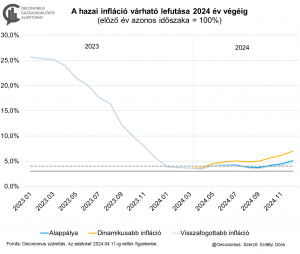
Food price developments in 2024, unlike the previous two years, could pull inflation down rather than up.Continue reading

Recent data from the Hungarian Central Statistical Office shows that the trajectory of inflation in Hungary has continued its downward trend into March 2024. This decline has been noteworthy, with inflation rates dropping from 3.8% in January to 3.7% in February, and further to 3.6% in March, compared to the same month in the previous year.
According to Magyar Nemzet, the Ministry for National Economy has credited this positive development to the effective measures implemented by the government, asserting that inflation has subsided rapidly, plummeting to merely one-seventh of the previous year’s rate.

Predicted rundown of domestic inflation until the end of 2024. (Blue: base line; Yellow: dynamic inflation; Thin blue line: subdued inflation) Picture: oeconomus.hu
However, notwithstanding this decline, Hungary has experienced a sustained deceleration in inflation, with consumer prices recording a 3.6% year-on-year increase in March. The month witnessed certain contributing factors to inflation, notably the price surges observed in TV and internet services, which collectively contributed to a monthly inflation rate of 0.8%.
Conversely, the stability in food prices during this period can be attributed to both global and domestic economic measures.
Nevertheless, there were notable increases observed in prices of vehicle fuel and household energy, with services witnessing the most significant surge.
Looking forward, projections suggest that inflation will likely remain below the 4% threshold in April, but there exists a possibility of it reaching or surpassing the 4% mark later in the year. The anticipated growth in real wages holds promise for bolstering consumption and spurring economic growth. Concurrently, it is imperative to note the differential inflation experiences of neighboring countries.
According to Oeconomus, Croatia, Estonia, and Poland have reported higher inflation rates compared to Hungary, while countries like the Czech Republic have witnessed lower rates.
Inflation in EU countries in February (blue) and March (yellow) 2024
In contrast, the Eurozone recorded an average inflation rate of 2.4% in March, providing a broader context for Hungary’s inflationary trends.
The continued moderation in inflation since September of the preceding year has facilitated a resurgence in consumer confidence. This, coupled with the gradual alleviation of precautionary motives, has catalyzed a recovery in consumption, particularly evident in retail sales. Such positive indicators have contributed to the overarching aim of the government, which is to reignite economic growth in 2024, following successful disinflationary measures.
To achieve this, a multifaceted approach is being adopted, encompassing a recovery in credit availability, heightened investment activity, sustained export performance, and a significant uptick in labor market activity.
Additionally, expanding consumption is anticipated to play a pivotal role in driving economic expansion, as underscored by the ministry in its statement.
In summary, the recent trends in inflation highlight both the resilience and adaptability of Hungary’s economy in the face of various challenges. While challenges remain, the concerted efforts of the government and positive economic indicators provide optimism for continued growth and stability in the months ahead.
Via Magyar Nemzet and oeconomus.hu; Featured Image: Pixabay